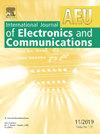非相干短包通信的BMOCZ调制解调优化方法
IF 3.2
3区 计算机科学
Q2 ENGINEERING, ELECTRICAL & ELECTRONIC
Aeu-International Journal of Electronics and Communications
Pub Date : 2025-05-12
DOI:10.1016/j.aeue.2025.155822
引用次数: 0
摘要
在基于共轭倒零二进制调制的非相干短分组通信(SPCs)中,噪声干扰和信道零分布严重降低了误码率(BER)性能。本文提出了一种将这两个干扰源解耦的系统调解调优化框架。在最大噪声容忍准则下,通过严格的理论分析,导出了基于噪声界的零星座半径。为了解决信道零干扰问题,提出了两种新的检测算法:区域划分最小寻根距离检测器(RDRFMD)和零重判最小寻根距离检测器(ZRRFMD)。进一步介绍了一种动态优化策略:在低信噪比(SNR)下,ZRNB结合RDRFMD优先抑制噪声,实现鲁棒检测;在高信噪比下,基于欧氏距离(ZRED)的零星座半径与ZRRFMD相结合,重点解决信道零干扰抑制问题。仿真结果表明,在无信道零干扰的情况下,ZRNB比原BMOCZ在BER为10−3时获得了0.6 dB的最大性能增益,而在随机信道零分布下,该方法在BER为10−1时获得了8 dB的显著性能提升。本文章由计算机程序翻译,如有差异,请以英文原文为准。
An optimized method of modulation and demodulation via BMOCZ for non-coherent short packet communications
In non-coherent short packet communications (SPCs) based on binary modulation on conjugate-reciprocal zeros (BMOCZ), noise interference and channel zero distribution critically degrade the bit error rate (BER) performance. This paper proposes a systematic modulation–demodulation optimization framework by decoupling these two interference sources. For noise mitigation, we derive a zero-constellation radius based on noise bound (ZRNB) through rigorous theoretical analysis under the maximum noise tolerance criterion. To address channel zero interference, two novel detection algorithms are proposed: a region-division root-finding minimal distance (RDRFMD) detector and a zero-rejudgment root-finding minimal distance (ZRRFMD) detector. A dynamic optimization strategy is further introduced: at low signal-to-noise ratio (SNR), ZRNB combined with RDRFMD prioritizes noise suppression for robust detection; at high SNR, a zero-constellation radius based on Euclidean distance (ZRED) integrated with ZRRFMD focuses on channel zero interference mitigation. Simulations show that ZRNB achieves a maximum performance gain of 0.6 dB over the original BMOCZ at BER of without channel zero interference, while the proposed method attains a significant 8 dB performance improvement at BER of under random channel zero distribution.
求助全文
通过发布文献求助,成功后即可免费获取论文全文。
去求助
来源期刊
CiteScore
6.90
自引率
18.80%
发文量
292
审稿时长
4.9 months
期刊介绍:
AEÜ is an international scientific journal which publishes both original works and invited tutorials. The journal''s scope covers all aspects of theory and design of circuits, systems and devices for electronics, signal processing, and communication, including:
signal and system theory, digital signal processing
network theory and circuit design
information theory, communication theory and techniques, modulation, source and channel coding
switching theory and techniques, communication protocols
optical communications
microwave theory and techniques, radar, sonar
antennas, wave propagation
AEÜ publishes full papers and letters with very short turn around time but a high standard review process. Review cycles are typically finished within twelve weeks by application of modern electronic communication facilities.

 求助内容:
求助内容: 应助结果提醒方式:
应助结果提醒方式:


